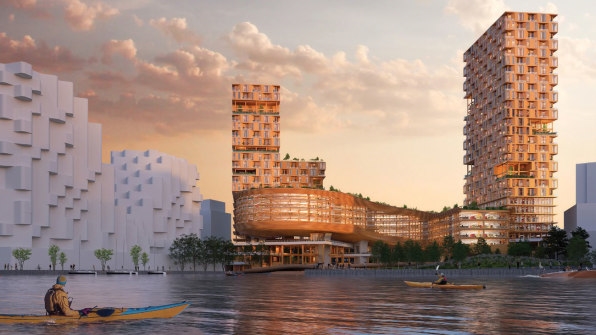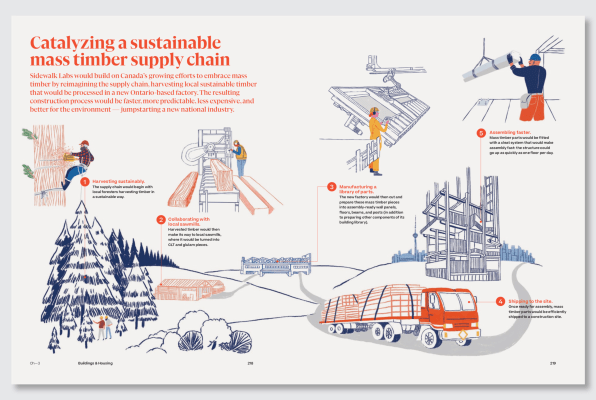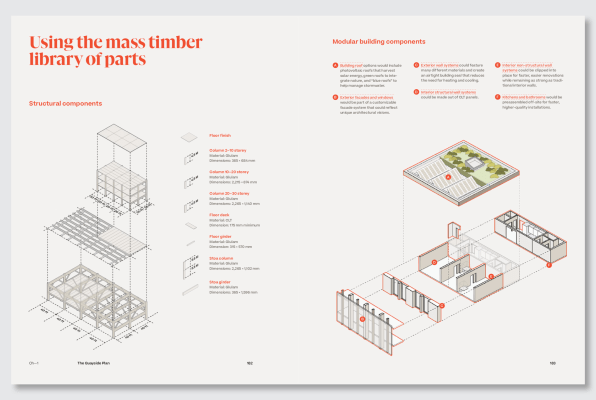Today, Google sister company Sidewalk Labs released a draft of its master plan to transform 12 acres on the Toronto waterfront into a smart city. The document details the neighborhood’s buildings, street design, transportation, and digital infrastructure—as well as how the company plans to construct it.
When a leaked copy of the plan popped up online earlier this year, we learned that Sidewalk Labs plans to build the entire development, called Quayside, out of mass timber. But today’s release of the official plan reveals the key to doing so: Sidewalk proposes investing $80 million to build a timber factory and supply chain that would support its fully timber neighborhood. The company says the factory, which would be focused on manufacturing prefabricated building pieces that could then be assembled into fully modular buildings on site, could reduce building time by 35% compared to more traditional building methods.
“We would fund the creation of [a factory] somewhere in the greater Toronto area that we think could play a role in catalyzing a new industry around mass timber,” says Sidewalk Labs CEO and chairman Dan Doctoroff.

However, the funding of the factory is dependent on Sidewalk Labs being able to expand its development plan to the entire riverfront district. The plan points out that Quayside’s 10 buildings are too few to make the factory’s $80 million investment—which will come from Sidewalk and other private partners who have yet to be determined—worth it.
Mass timber is an emerging building material that’s made out of pieces of wood laminated together to make them stronger. It has been hailed by many scientists and architects as the future of building because it is just as strong as steel, more fire-resistant than regular wood, and is environmentally friendly to boot: After all, a tree pulls carbon out of the atmosphere, while making steel and concrete generates emissions though some scientists debate that it’s better to leave trees in the ground). And the building material is growing in popularity: according to Sidewalk, there have been 21 timber towers taller than seven stories completed or under construction since 2013.

[Image: courtesy Sidewalk Labs]
Sidewalk proposes sourcing spruce and fir trees from the forests in Ontario, Quebec, and British Columbia. While Canada has 40% of the world’s sustainable forests, Sidewalk claims, the country has few factories that can turn these trees into the building material. That’s why the company proposes starting a factory to process two kinds of mass timber: Cross-laminated timber (CLT) and glulam beams. The latter is meant specifically to bear the weight of the 30-story buildings Sidewalk hopes to build. While Sidewalk says that 84% of the larger district would be handed over for development by local companies, the plan requires that these companies uphold the same sustainability standards when it comes to performance.
Sidewalk says companies wouldn’t be required to build with CLT and glulam, but since the company’s reason for building the mass timber factory is that there aren’t many existing manufacturers to meet the needs for a full-scale development, the company’s plan might ultimately push any third-party developers toward using its factory to source materials.

The primary way that Sidewalk aims to reduce construction time is by designing the buildings to be completely modular, using a smaller kit of parts: “To accelerate project timelines, improve predictability, and reduce costs in a holistic way, Quayside’s buildings would draw from a complete library of factory-made building parts that can be customized for each project to allow for a diverse and interesting variety of buildings that achieve design excellence,” the plan states.
To demonstrate how this would work from a design perspective, Sidewalk Labs asked three architecture firms—Heatherwick Studio, Snohetta, and Michael Green Architecture—to use the same set of modular pieces to come up with building designs for different parts of the Quayside development. The plans, which were released in February, are all vastly different. Michael Green Architecture’s renderings reveal skyscrapers with wooden slats along their exteriors, while Snohetta’s feature a large curved facade paired with two towers. Heatherwick’s buildings have a layered, organic form. All of the renderings are just concepts for the time being, and the company says they do not reflect final design or engineering decisions.

The factory is also key to another of Sidewalk’s promises: Jobs. According to Sidewalk, the factory itself would create 2,500 jobs along the entire supply chain over a 20-year period. But even if the Canadian government approves Sidewalk’s plan and commits to building out the entire waterfront district to take advantage of the mass timber factory’s economies of scale, there are other regulatory hurdles to overcome. Right now, the building code in Toronto doesn’t allow for timber buildings over six stories tall. All of Sidewalk’s proposed buildings are over six stories, and many of them go up to 30 stories. Doctoroff said he was optimistic that the company will be able to get regulations changed if the city decides to adopt the plan. There are several examples of timber buildings that are already under construction, with a planned skyscraper in Japan that will be 70 stories.
Sidewalk’s proposal is the result of 18 months of planning, which involved getting feedback from community members and prototyping elements like a building raincoat that the company hopes to include in the final development. It has come under fire from privacy advocates in particular, and the Canadian government is currently facing a lawsuit from a civil liberties group over its decision to allow a corporation to propose public privacy governance standards.
Now that the company has released the plan, it will be up to the Canadian government to decide whether to move forward. And the mass timber factory, in particular, will be dependent on the government adopting Sidewalk’s plan wholesale, far beyond the Quayside development—a reminder that Sidewalk is a corporation that’s here to make money, dangling investment dollars in front of the government to incentivize it to embrace Sidewalk as the developer for the entire area.
(28)